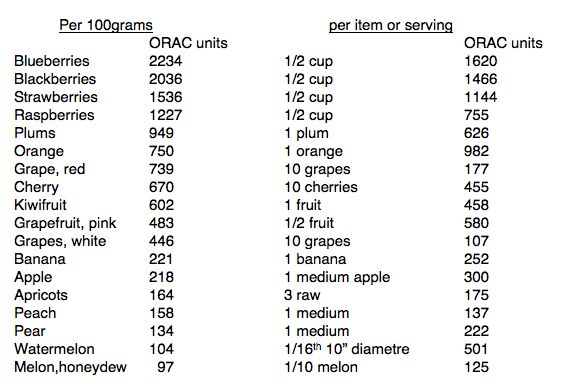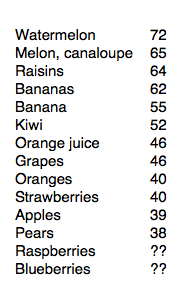A study out this week has identified exceptionally high content of polyphenols and anti-cancer ellagic acid in their seeds [1], as well as zincWhat it does: Component of over 200 enzymes in the body, essential for growth, important for healing, controls hormones, aids ability to cope with stress…, which is vital for a healthy sex life. The more sex a man has the more strawberries and raspberries they need to keep fully loaded – sperm production being totally dependent on zinc.
While the Government recommend we all eat five servings of fruits and vegetable a day not all fruits are equal. Strawberries and raspberries can conquer colds, boost your energy levels, improve your concentration, turn back the ageing clock and even keep you cancer-free. In fact, a few strawberries a day keeps the doctor away than an apple or orange.
How can any fruit claim all these benefits? “Strawberries and raspberries contain ten essential nutrients, five of which you won’t find in any multivitamin pill.” Says Holford. Eating berries is way more powerful than just eating apples and oranges. A serving of strawberries or raspberries gives you three times more health benefit than most fruits.
Seven Reasons to Eat Strawberries and Raspberries
1. Vitamin CWhat it does: Strengthens immune system – fights infections. Makes collagen, keeping bones, skin and joints firm and strong. Antioxidant, detoxifying pollutants and protecting against…
What’s the best fruit for vitamin C? Oranges? Kiwis? No, it’s strawberries, closely followed by raspberries. Strawberries contain the most vitamin C (per calorie), and they are the only British fruit with significant amounts. In fact it’s one of the best dietary sources of vitamin C. Vitamin C not only prevents colds and infections, its well known that a high dietary intake halves your risk of cancer. Vitamin C also promotes healthy, firm skin free of wrinkles. “This is because collagen, the glue between your skin cells, is made from vitamin C. 200grams, which is ‘a cup’ (200g), gives 150% of the RDA, namely 120mg of vitamin C. That’s more than a 200g orange – 100g of orange equals 50mg.” Strawberries and raspberries have almost four times as much vitamin C as blueberries. [2]
2. AntioxidantAntioxidants are substances that protect cells within the body from damage caused by free radicals. They help to strengthen the body’s ability to fight infection… Power
That’s not all that makes berries, especially strawberries and raspberries, superfoods. They also contain other very important antioxidants and polyphenols – mainly anthocyanins, ellagic acid and flavones which have very powerful anti-cancer properties) that make them the best all-round foods for anti-ageing antioxidants.
The big buzzword in health and nutrient is antioxidants. Put simply, the exhaust fumes of the body, made when we turn energy into food, are called oxidants. When you breathe in car exhaust, cigarette smoke, polluted air, or eat burnt or fried food, or even tan your skin in sunlight, you are increasing your oxidant exposure, which not only ages you faster, but also increases the risk of many diseases, including cancer. That’s the bad news.
The good news is that the more antioxidants and polyphenols you more years you add to you life – and life to your years. Scientists have been measuring which fresh fruit have the most antioxidant power. The answer is berries – blueberries, blackberries, strawberries and raspberries. As you can see from the chart below half a cup of strawberries has more antioxidant power than three apples, or four bananas.

3. Anti-cancer Nutrients
There’s far more to strawberries and raspberries that meet the eye. They are exceptionally high in four known anti-cancer nutrients called anthocyanins, ellagic acid, isothiocyanates and quercitin (more on this later).
These key nutrients in strawberries and raspberries makes them top anti-cancer foods. A common cancer-producing chemical found in some meats, called nitrosamine, is put out of action by strawberries. In fact, research has shown that strawberries are second only to garlic for their anti-cancer properties against nitrosamines. [3] One of the reasons, apart from their high antioxidant levels, that strawberries and raspberries come out top is that they are very high in another anti-cancer nutrient, called ellagic acid. According to research at the Indiana University School of Medicine in the US, ellagic acid in strawberries and raspberries protect healthy cells from developing into cancer cells. [4] Ellagic acid also protects you from another common carcinogen, aflatoxin. [5] This is found in low levels in a number of foods, including peanuts. Strawberries and raspberries are also high in another anti-cancer nutrient called isothiocyanates. Isiothiocyanates don’t just help prevent cancer, they reverse it by killing cancer cells. These berries have been shown to inhibit cancer development in cervical [6], oesophageal [7] and oral cancer [8], and probably prostate cancer.
The prestigious Mayo Clinic in the US have been conducting research into quercitin to help treat and prevent prostate cancer, the fastest rising cancer, now affecting one in six men at some point in their life. In the words of the Mayo Clinic researcher Dr Nianzeng Xing, our laboratory results showed quercitin blocks the androgen activity in androgen-responsive human prostate cancer cells. By blocking the androgen activity,” he continued, “the growth of prostate cancer cells can be prevented or stopped.”
4. Berries are rich in Folate, the 21st Century Panacea
Described in the British Medical Journal as a ‘leading contender for panacea of the 21st century’ [9] this B vitamin not only prevents pregnancy problems and miscarriages, it also relieves depression, lowers heart disease risk, improves memory and concentration. A serving of strawberries gives you 125mcg of folic acidWhat it does: Critical during pregnancy for the development of a baby’s brain and nerves. Also essential for brain and nerve function. Needed for utilising…, which is more than half of the day’s requirement for folic acid, and more than three times that in oranges or apples. Folic acid lowers your homocysteineHomocysteine is an amino acid found in the blood. Elevated levels of homocysteine have been associated with narrowing and hardening of the arteries, an increased… level, now thought to the single greatest measure of a long and healthy life, free from heart disease, cancer and diabetes.
Strawberries contain up to (335-644 per 100g dry weight). This means that a punnet (250g) of fresh strawberries gives you 125mcg of folate, roughly half the RDA. [10] An apple gives you 1mcg and a pear gives you 2mcg. So there’s fifty times more in berries.
5. Low sugar and low Glycaemic Index = Great for Weight
The best way to lose weight is to avoid sugar and keep your blood sugar level even. Berries come out top of all the fruits in this respect. Even the Atkins Diet, notoriously low in fruit, recommends eating berries to lose weight. “Berries are lower in carbs than other fruit and are relatively low on the glycemic index scale.’ said the late Dr Atkins, who recommended berries as part of his weight loss diet. Strawberry seeds are exceptionally high in fibreFibre is an important part of a balanced diet. There are two type of fibre; soluble and insoluble. Insoluble fibre helps your bowel to pass….
The ‘glycemix index’ is a measure of how much a food raises a person’s blood sugar level. The higher the score, as far as weight loss and energy are concerned. Stable weight and stable energy are achieved by eating foods with a low glycemic index score. As you can see from the chart below, berries come out best:

6. Think Zinc
There’s something special in berries that you’ll throw away in apples and oranges – it’s the seeds. Seeds are where a fruit keeps all its goodness for a very simple reason: its survival. Once an animal eats the fruit, the seeds are deposited which a manure-rich starter kit, and the new fruit plant grows. The seeds contain the essential nutrients needed to allow the plant to flourish and it is these very nutrients that allow us to flourish as well. One of these key nutrients is the mineral zinc. Nothing grows without zinc – from plants to babies. Sperm, the human seed, is packed with zinc. Oysters, the richest known source of zinc are indeed an aphrodisiac for this very reason. All seeds, including those in berries, are rich in zinc. The best of all are raspberries (0.3mg/100g), followed by bananas (02.mg/100g), which also contain their seeds, followed by strawberries (01.mg per 100g).
7. Quercitin – the Antidote to Hayfever
Nature usually provides a solution to cope with ailments such as hayfever – and it’s strawberries. Why? Because strawberries, as well as other berries, are especially high in a quirky bioflavonoid call quercitin. Quercitin, along with other bioflavanoids in berries, can also improve the health of capillaries and connective tissues. Because of this, the many benefits of quercitin include alleviating bruising, oedema, varicose veins, and fragile capillaries. A major benefit is its ability to inhibit the release of histamineHistamine is a chemical naturally produced by various cells in the body. A large amount of histamine is produced within mast cells where it forms…. As such, it is said to help mitigate conditions brought on by some type of allergin (ex. eczema, asthma, hay fever, etc) and has been ascribed anti-inflammatory properties, which means berries could be good for arthritis sufferers as well.

So, which is the best fruit of them all? I’ve used five criterion: zinc content, folate content, overall antioxidant content (ORAC), glycemic index and vitamin C content. The winner was raspberries, followed by strawberries and blueberries in equal second place. “Berries are as close as you can get to the perfect fruit. I recommend a serving of berries every day – that, more than an apple, is likely to keep the doctor way.
If you can’t get them fresh have a shot of Blueberry Active or sprinkle some dried blueberries on your cereal
Visit HOLFORDirect.com home of GL friendly foods, supplements, books and tests.
REFERENCES
1. Grzelak-Blaszczyk K et al, Food Science and Technology, 2017
2. Kalt W et al, J Agric Food Chem, 1999
3. Chung MJ, Lee SH, Sung NJ, Cancer Lett, 2002
4. Xue H et al, Carcinogenesis, 2001
5. Loarca-Pina G et al, Mutat Res, 1996
6. Narayanan BA et al, Cancer Lett, 1999
7. Stoner GD et al, Toxicol Sci, 1999
8. Casto BC et al, Anticancer Res, 2002
9. Smith R, ‘Let Food be your medicine’ Editors Choice, BMJ 2004;328 (24 Jan)
10. Stralsjo LM et al, J Agric Food Chem, 2003

Comments
Join the Conversation on our Facebook Page